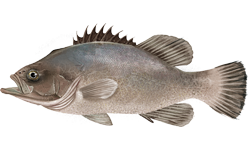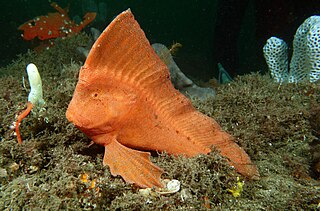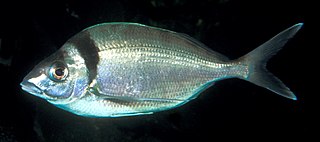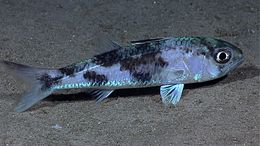
Anoplopomatidae, the sablefishes, are a small family of ray-finned fishes classified within the order Scorpaeniformes. This family is the only family in the monotypic superfamily Anoplopomatoidea. These fishes are found in the North Pacific Ocean.

Congiopodidae, commonly known as pigfishes, horsefishes and racehorses, is a family of ray-finned fish classified with in the order Scorpaeniformes. These fishes are native to the Southern Hemisphere.

The wreckfish are a family, Polyprionidae in the suborder Percoidei of the order Perciformes.

The Australian prowfishes are a small family, the Pataecidae, of ray-finned fishes classified within the order Scorpaeniformes. Australian prowfishes are distinguished by a long dorsal fin that begins far forward on the head, forming a "prow" shape, and extends all the way to the caudal fin. They lack scales and pelvic fins.

Bothragonus is a genus of marine ray-finned fishes belonging to the family Agonidae, the poachers and related fishes. It is the only genus in monotypic subfamily Bothragoninae. These fishes are found in the northern Pacific Ocean.

Pleurogrammus is a genus of ray-finned fishes belonging to the family Hexagrammidae, the greenlings, known as Atka mackerels. These fishes are found in the northwestern Pacific Ocean.
Hozukius is a genus of marine ray-finned fishes belonging to the subfamily Sebastinae within the family Scorpaenidae. They are native to the northwestern Pacific Ocean.

Acropoma is a genus of fish in the family Acropomatidae, the temperate ocean-basses or lanternbellies. They are native to the Indian Ocean and western Pacific Ocean. They are characterized by a ventral luminous organ that has a luminous gland, a lens, and a reflector. The shape of the luminous organ helps distinguish the species in the genus.
Malakichthys is a genus of fish in the family Acropomatidae, the temperate ocean-basses or lanternfishes. They are native to the Indian Ocean and the western Pacific Ocean.

Neoscombrops is a genus of marine ray-finned fishes from the family Acropomatidae, the lanternbellies or glowbellies. The fish in this genus are found in the Atlantic Pacific and Indian Oceans.

Verilus is a genus of fish in the family Acropomatidae found in the Atlantic.

Nemadactylus is a genus of marine ray-finned fish, traditionally regarded as belonging to the family Cheilodactylidae, the members of which are commonly known as morwongs. They are found in the South Atlantic, Indian and South Pacific Oceans.

Acropoma japonicum, the glowbelly, is a fish species in the family Acropomatidae found in the Indo-West Pacific. It is a benthopelagic predatory fish with a bioluminescent organ on its ventral surface. The glowbelly is an important food fish in some areas.
Acropoma lecorneti is a species of ray-finned fish, a lanternbelly from the family Acropomatidae. It is found in the western Pacific Ocean where it has been recorded off Japan and New Caledonia. This species was first formally described by the French ichthyologist Pierre Fourmanoir (1924-2007) with the type locality given as north of the St Vincent Pass off the western coast of New Caledonia at a depth of 360 metres (1,180 ft). The specific name honours the skipper of the fishing boat Thalassa, Monsieur Lecornet, who took the type aboard that vessel.
Parascombrops pellucidus is a species of perciform fish in the Family of Acropomatidae.
The thinlip splitfin is a species of fish in the family Acropomatidae, the lanternbellies. It lives around Africa's Atlantic coast at a depth of 50–500 m and can grow up to 16.5 cm long.
The three-spine bass is a species of ray-finned fish, a lanternbelly from the family Acropomatidae. It is a deep water species which is found in the western Atlantic from the northeastern Gulf of Mexico to Surinam. This fish was first formally described in 1984 as Synagrops trispinosus but in 2017 was placed in the monotypic genus Caraibops.

Paracombrops is a genus of marine ray-finned fishes from the family Acropomatidae, the lanternbellies or glowbellies. The fish in this genus are found in the Indo-Pacific.

The mangrove waspfish, also known as the goblinfish, is a species of marine ray-finned fish, a waspfish belonging to the subfamily Tetraroginae, which is classified as part of the family Scorpaenidae, the scorpionfishes and their relatives. This species occurs in the Indo-Pacific region.
Askoldia is a monotypic genus of marine ray-finned fishes belonging to the family Stichaeidae, the pricklebacks and shannies. Its only species is Askoldia variegata which is found in the northwestern Pacific Ocean.













